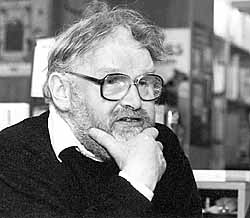Gray, Alasdair
Enlarge text Shrink text- His Lanark, c1980:t.p. (Alasdair Gray) pub. info. with CIP (writer and painter; lives in Glasgow)
- His Old negatives, 1989:t.p. (Alasdair Gray) jkt. (b. 1934)
- Literature Resource Centre www site 10 Aug. 2007:Alasdair Gray page (Alasdair James Gray. Born December 28, 1934, in Glasgow)
Alasdair James Gray (28 December 1934 – 29 December 2019) was a Scottish writer and artist. His first novel, Lanark (1981), is seen as a landmark of Scottish fiction. He published novels, short stories, plays, poetry and translations, and wrote on politics and the history of English and Scots literature. His works of fiction combine realism, fantasy, and science fiction with the use of his own typography and illustrations, and won several awards. He studied at Glasgow School of Art from 1952 to 1957. As well as his book illustrations, he painted portraits and murals, including one at the Òran Mór venue and one at Hillhead subway station. His artwork has been widely exhibited and is in several important collections. Before Lanark, he had plays performed on radio and TV. His writing style is postmodern and has been compared with those of Franz Kafka, George Orwell, Jorge Luis Borges and Italo Calvino. It often contains extensive footnotes explaining the works that influenced it. His books inspired many younger Scottish writers, including Irvine Welsh, Alan Warner, A. L. Kennedy, Janice Galloway, Chris Kelso and Iain Banks. He was writer-in-residence at the University of Glasgow from 1977 to 1979, and professor of Creative Writing at Glasgow and Strathclyde Universities from 2001 to 2003. Gray was a Scottish nationalist and a republican, and wrote supporting socialism and Scottish independence. He popularised the epigram "Work as if you live in the early days of a better nation" (paraphrased from Canadian poet Dennis Lee's poem Civil Elegies) which was engraved in the Canongate Wall of the Scottish Parliament Building in Edinburgh when it opened in 2004. He lived almost all his life in Glasgow, married twice, and had one son. On his death The Guardian referred to him as "the father figure of the renaissance in Scottish literature and art".
Read more on Wikipedia >
 Personality
Personality


 by Guenter Prust.jpg)




